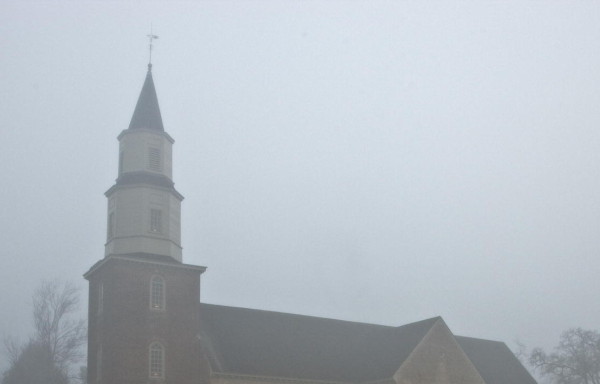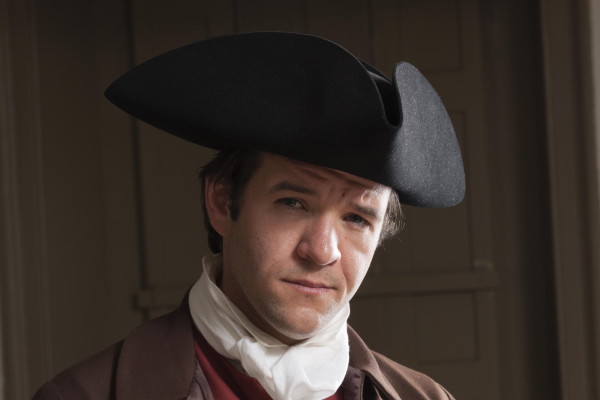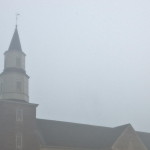
Future first lady Martha Washington goes through her daily devotions. A young James Madison muses over the meaning of a proposed bill for religious toleration. Baptist preacher Gowan Pamphlet leads his congregation in singing an African greeting. But what’s behind the dramatic portrayals?
Colonial Williamsburg observes Religion Month in April, spotlighting programs with spiritual themes. The interpreters who bring Martha Washington, James Madison and Gowan Pamphlet to life have devoted years to understanding their subjects—and for some, perhaps their alter egos. How do they articulate 18th-century religion to a 21st-century audience?
“You’re not just getting what happened in church.” —Bryan Austin
All three are quick to point out that religion permeated every aspect of colonial and revolutionary Virginia. “Religion was the most important part of people’s lives. It was your government, it was your church, it was your life,” says James Ingram, who has been bringing Baptist preacher Gowan Pamphlet to life for 15 years.
If you took religion out of Williamsburg, says Lee Ann Rose, who portrays Martha Washington, “I think you’d lose a sense of who [Martha] was and who these people were. Church is a part of their lives. They went there to find out their news, they went there to have their community and they went there to find their God.”
Bryan Austin, who portrays a 20-something James Madison, agrees. “When you see Religion Month programming, guests might think it’s just [church], but there’s such diversity. It’s religion and government, it’s religion and education, religion and society, religion and slavery. You’re not just getting what happened in church.”
Exploring the Characters
The interpreters, who represent only a small sample of Williamsburg’s diverse Revolutionary City cast, seem to empathize strongly with their characters. Austin puts his finger on part of what makes them different from each other. It’s a matter of where these people confront their spirituality: through personal faith, organized religion or government policy.
“With Madison, it always comes back to the funnel of government,” he says. “You get these people who talk about liberty on the streets—who talk about freedoms. But you really leave out a major thing if you just say liberty. Well, what liberty? As Madison I say, it’s the right that every other right is derived from. Before you can think of any other rights you have, you’ve got to have the ability to think freely first. Religion falls into that [category of free conscience]. That’s part of the reason I find that big difference between religion and faith, particularly as Madison. Religion to him denotes that man-made part, the ecclesiastical establishment, whereas faith is derived from reason and opinion and intellect.”

Ingram sees Gowan Pamphlet through the prism of organized religion, especially the story of how Protestant dissenters helped to fuel the revolutionary spirit. “Guests are shocked. You can just see the lightbulbs going on as I talk about these different religious groups and their effect on society and life in America. They are stunned to even hear their denomination talked about as plainly as part of the fabric of the country. You can see a little pride when they hear about their particular denomination being part of this [revolutionary] cause.”
Rose, whose father was a Presbyterian minister, sees Martha Washington’s faith on a more personal level. “It was extremely private to them. It wasn’t something that was showy for them, even though Martha was probably more showy about it than George was.”
Sources of Inspiration
A lot of work goes into finding out as much as possible about the people they portray. “When I first started to do Gowan, we only had two paragraphs and that was mostly conjecture,” recalls Ingram. Thanks to a trove of material unearthed through the Baptist Historical Association, he has a much fuller picture today. “All of a sudden we’ve got volumes of information about Gowan. His bio is now one of the most complete for any slave in America. We have it firsthand that he did a lot of the things we talk about.”
Austin, in contrast, is still getting to know Madison. “I had the benefit when I first arrived of sitting down for about two months, to do 9 to 5 research on Madison as I was preparing to play him as president.” But he was years away from becoming either chief executive or the “father of the Constitution.”
“In framing this program, I knew where it ended,” says Austin. “It was really doing the detective work of where it started. So in this program I delve a little bit into those future notions, but I like leaving it unsure, saying ‘I don’t know if this is going to work, but it’s what I believe.’ I think that’s part of what’s interesting about playing young Madison. I don’t have all the answers. In fact it’s kind of fun to not have them.”
What goes into finding out what made these people from long ago tick? “Whenever you want to figure out what a person thinks, it’s not going to the biographies, it’s going to the primary sources,” says Austin. I’ve spent a lot of time with the various things Madison writes about religion, from the [Virginia] Declaration of Rights through to the Memorial and Remonstrance Against Religious Assessments [in 1785], which I think is the best source of not only him standing as an advocate of that liberty of conscience, but it’s also one of the first times he stands out as someone that people notice.”
Rose agrees. “You see several of [Martha Washington’s] letters where she mentions God and biblical writings very distinctly. Her granddaughter writes that she started her morning with devotions to God and she ended her day with God. You have Rev. Mr. Macey writing about the Washingtons being oh-so-reverential at church and that they did not let company keep them from church. They would often bring company with them.”
Making Them Real
So how do you turn those primary sources into a flesh-and-blood interpretation of that person? “For me,” says Rose, “some of it is conjecture. I mean, how does a woman get out of bed after losing four children? How does a woman go on with her life when she’s the oldest of eight children, and all her siblings die before her? How does this woman go to every winter camp and see what she saw if there wasn’t a great love of the Lord or a great faith to keep her going?”
But this isn’t necessarily the Martha Washington known to Americans of her time. “There is that public face and the private face. What you [hear] on the stage is what she would tell her most intimate friends.”
Rose frequently cites one particular quotation directly. In a letter to her friend Mercy Otis Warren, who became famous in her own right for her history of the Revolution and other writings, Martha Washington wrote: “The great part of our misery or happiness depends on our dispositions and not on our circumstances.”
Ingram finds Pamphlet’s voice “in the reading of the historical sources, although we don’t have a lot that Gowan actually wrote. We can get pretty close with 18th-century sermons from preachers, even some black preachers like Christopher McPherson, who Gowan knew personally. I normally read the audience and take a certain road in my sermon. I try to arm myself with so much information that no matter where you drop me, I’m able to talk about any angle of the history at any given time.”
“When I arrived here 19 years ago, I kind of felt like [these stories were] a need for the country. I think this place has a calling to tell this story because no one else is telling it.”
Indeed, Colonial Williamsburg offers something special, says Austin. “I think there are certain things that are a bit taboo with modern audiences: politics and religion. How often do you go up to somebody on the street and talk to somebody about that?”
Religious programs get center stage in April, but look for them all year long in the Revolutionary City. Religion Month activities are generously supported by a gift from the Kern Family Foundation.

